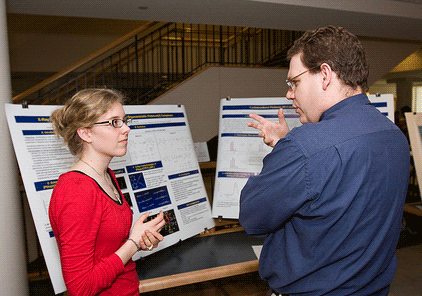Poster Title
Faculty Advisor
Erick Agrimson, Sue Hummel and Tammi Wiesner
Department
Sonography
Abstract
A revolutionary method to molding the benefits of multiple imaging modalities is in the form of Ultrasound Fusion, which allows a previous data-set such as an MRI, PET, CT or even a previous ultrasound, to be fused together while performing real-time imaging with an ultrasound machine. There are many applications to this innovative type of imaging such as diagnostic procedures, interventional guidance, biopsies, and follow-up studies. The science behind ultrasound fusion is that of a controlled atmosphere; an electromagnetic plate under the patient’s bed, works with GPS position sensors on the transducer. Certain points on the two image modalities are marked and then through pattern recognition, they are aligned. This allows medical personal to visually detect and characterize any pathology or areas of interest. Clinical studies have been conducted using Ultrasound Fusion such as prostate biopsy guidance to rule out prostate cancer from previous CT scans, as well as the evaluation, characterization, and vascularization of liver tumors previously detected on MRI or CT scans. It is clear that Ultrasound Fusion has a significant future in the imaging community; enhancing diagnostic confidence by maximizing visual image modalities.
Start Date
19-4-2012 11:00 AM
End Date
19-4-2012 1:00 PM
Ultrasound Fusion
A revolutionary method to molding the benefits of multiple imaging modalities is in the form of Ultrasound Fusion, which allows a previous data-set such as an MRI, PET, CT or even a previous ultrasound, to be fused together while performing real-time imaging with an ultrasound machine. There are many applications to this innovative type of imaging such as diagnostic procedures, interventional guidance, biopsies, and follow-up studies. The science behind ultrasound fusion is that of a controlled atmosphere; an electromagnetic plate under the patient’s bed, works with GPS position sensors on the transducer. Certain points on the two image modalities are marked and then through pattern recognition, they are aligned. This allows medical personal to visually detect and characterize any pathology or areas of interest. Clinical studies have been conducted using Ultrasound Fusion such as prostate biopsy guidance to rule out prostate cancer from previous CT scans, as well as the evaluation, characterization, and vascularization of liver tumors previously detected on MRI or CT scans. It is clear that Ultrasound Fusion has a significant future in the imaging community; enhancing diagnostic confidence by maximizing visual image modalities.

